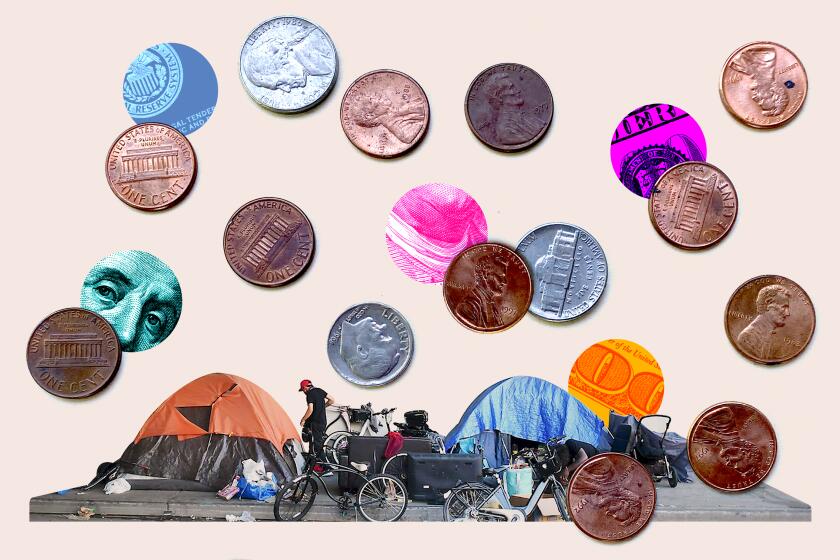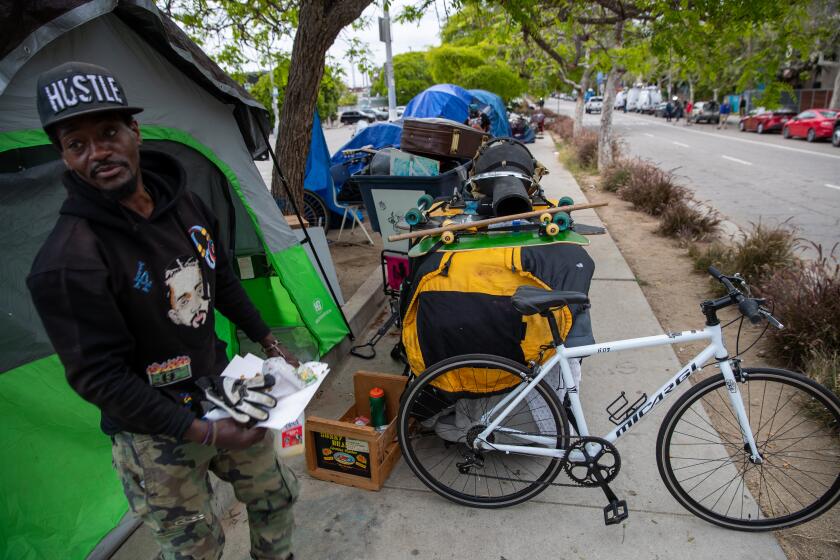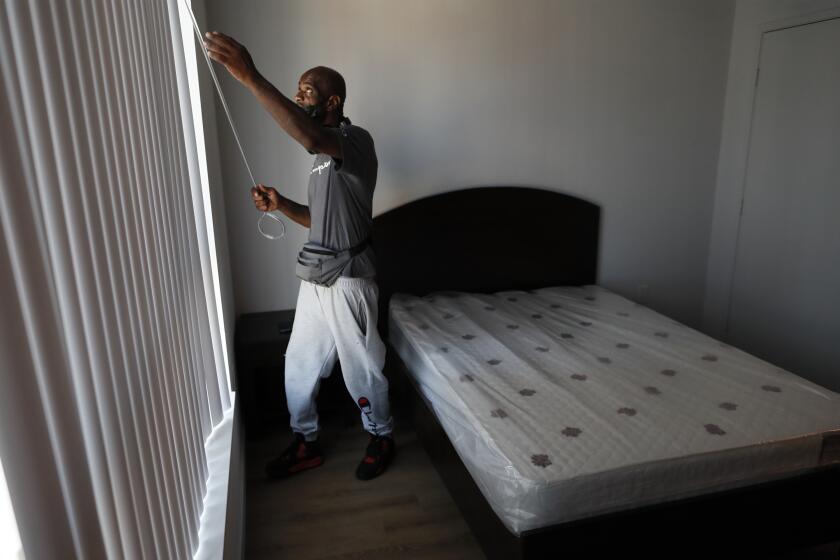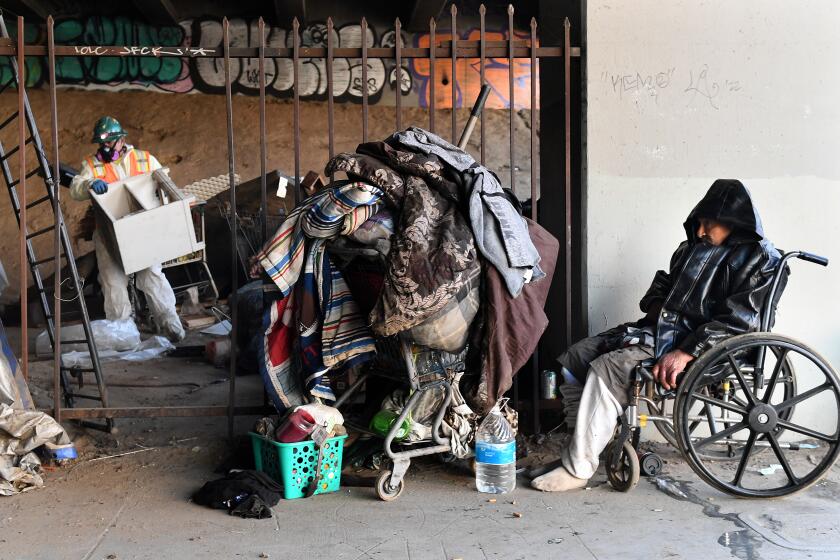California has billions to spend on mental health. Where should the money go?
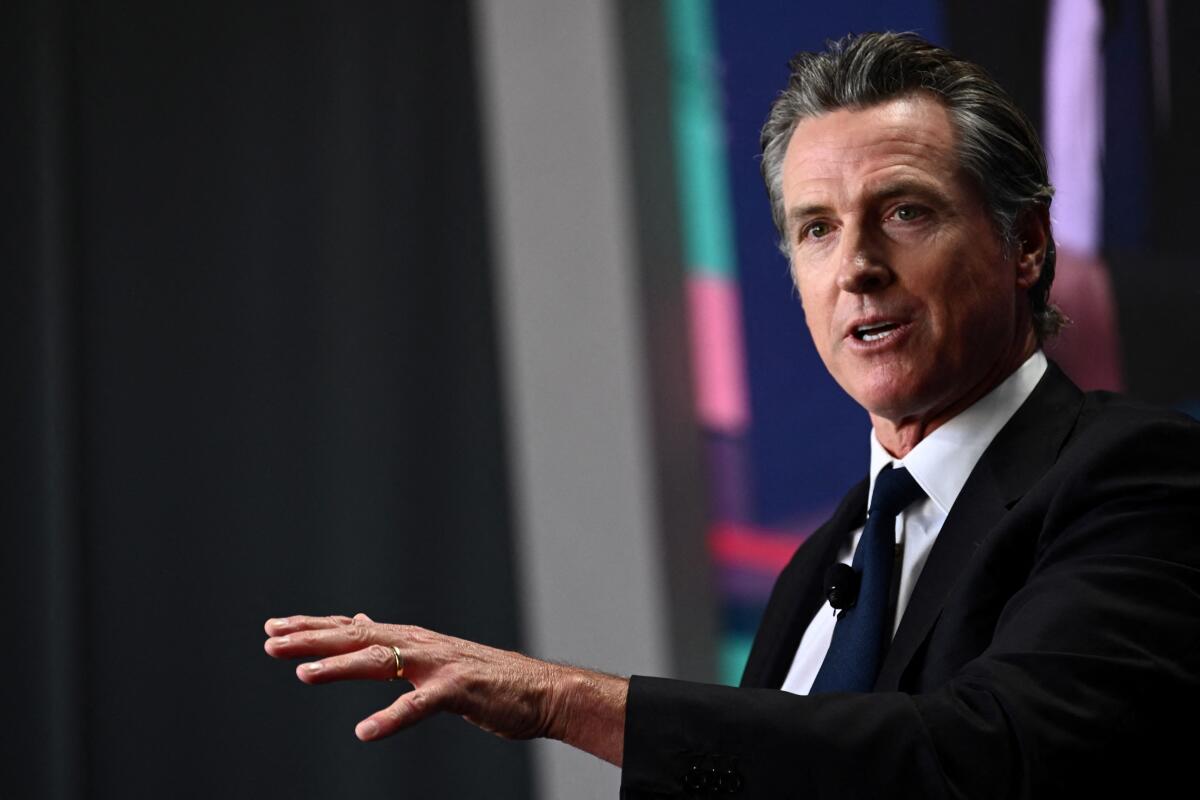
It was a ballot initiative born out of a lack of hope from advocates that Sacramento would ever fund the public mental health system.
Proposition 63, passed by voters in 2004, created Californiaâs âmillionairesâ tax,â a 1% income tax on the stateâs wealthiest, sent directly into the county coffers to spend on their mental health systems.
In almost 20 years, the tax has brought in an estimated $26 billion, more than double of what lawmakers ever thought possible when they proposed the tax through legislation, the Mental Health Services Act.
Gov. Gavin Newsom, who advocates agree has focused more on mental health than prior governors, says itâs time to âmodernizeâ how that money is spent â namely taking 30% of it, or about $1 billion a year, to spend only on housing for those with serious mental illnesses, substance use disorders or both.
A funding carve-out for housing would be a fundamental shift in how counties spend the money â arguably some of which goes to housing support â and Los Angeles County leaders fear the administration is creating unfunded mandates that will result in cuts to services for adults and children who need the most care.
Newsom announced two bills â Senate Bill 326 by Sen. Susan Talamantes Eggman (D-Stockton) and Assembly Bill 531 by Assemblymember Jacqui Irwin (D-Thousand Oaks) â in June that carry his administrationâs plans to alter how mental health funds are spent.
AB 531 is the less controversial of the two â it would place a $4.68-billion bond measure on the March 2024 ballot. This one-time funding would be used to create thousands of mental health and substance use disorder beds.
SB 326 is the focus of much debate. It is scheduled for a hearing Aug. 16 in the Senate health committee. Both bills are tentatively scheduled to be heard in the health and housing Assembly committees Aug. 22 â the same day mental health advocates plan to rally to fight SB 326. If approved by the Legislature, the measure would be on the March ballot and go into effect in July 1, 2026. Like any piece of legislation, both can be amended.
Letâs dive into the how, why and history of this funding mechanism and the current debate between the Newsom administration and L.A. County leaders about how the money should be spent.
A millionaireâs tax was helping fund new mental health programs in California. But the Great Recession changed things â and counties got desperate.
Where did this idea, the Mental Health Services Act, come from, and why?
In the 1960s, there was a major push in California and nationally to close asylums and treat people with serious mental illnesses in their communities. But California, like every other state, never fully funded its community-based mental health system, in part because federal funding never came.
Over the next four decades, advocates and the occasional state lawmaker pitched reforms and made funding pleas to the Legislature, but were never successful in finding a dedicated funding source that would stand the tests of time and recessions. (This is unlike education leaders, who were successful in getting Proposition 98 passed in 1988, which established a minimum funding guarantee for education in the stateâs Constitution.)
Out of this frustration, Proposition 63, created by the Mental Health Services Act, was crafted.
âThis initiative was needed because it was clear that there was no way that mental health could ever become a sufficient legislative priority to achieve its needed funding in any other way,â the late Rusty Selix, the initiativeâs co-author, told the Little Hoover Commission in September 2014.
Mental health services and homelessness were not the top-of-mind issues they are today, and just over half of voters approved the measure, Sacramento Mayor Darrell Steinberg, who co-authored the initiative while in the Legislature, said in June.
Continuing a persistent rise over the last several years, homelessness was estimated to have increased 10% in the city of Los Angeles in 2022 and 9% across the county.
Steinberg said counties have succeeded in getting tens of thousands of people into services through Mental Health Services Act money.
âBut the truth of the matter is, itâs long past time to modernize the Mental Health Services Act,â he said.
How much money are we talking about?
Lawmakers originally estimated the fund would generate $600 million a year. They didnât anticipate how the money â or number of Californians earning more than $1 million â would grow, thus ballooning the fundâs budget, Steinberg said.
Over the past 18 years, the Mental Health Services Act has funneled $25.6 billion to Californiaâs mental health system since its inception, according to data provided by the Mental Health Services Oversight And Accountability Commission. The majority, 95%, goes directly to counties.
L.A. County has received $7.2 billion of that, including $873 million during the 2021-22 fiscal year, according to data provided by the Mental Health Services Oversight And Accountability Commission.
Not adjusting for inflation, thatâs almost 10 times the $89.7 million the county received in the 2005-06 fiscal year.
California is expecting a whopping $4.7 billion in Mental Health Services Act money for the 2023-24 fiscal year â and L.A. County generally receives about one-fourth of the total, according to data provided by the Legislative Analystâs Office. That is more than double than the funding provided in the previous fiscal year. (Billionaires did well in the COVID-19 pandemic.)
(An important if semicomplicated note: The exact amount of money that L.A. County receives comes with several caveats related to state finance practices, and the above numbers are strictly the amount of revenue L.A. County received per budget year. The state pays counties per month using tax estimates and other data, and about a year later, will send counties lump sum payments of how much more tax money the county should have received for a previous year. For example, later this year, L.A. County expects to receive about $1 billion more from a previous funding cycle. The payments arenât usually quite this significant.)
Voters approved this back in 2004. How has L.A. County used the money since then?
The Mental Health Services Act dictates how the counties spend the money, the majority of which is geared toward paying for consistent mental healthcare for adults and children with serious mental health needs.
L.A. County uses some of the money to pay for a âwhatever it takesâ approach, called âfull service partnerships,â where the county contracts with healthcare organizations to not only provide therapy but also help patients find transportation to care, housing, a job and other support.
Lisa Wong, director of the L.A. County Department of Mental Health, said her agency spent about a third of its money last year on outpatient treatment for those with serious mental illnesses. It also funded crisis mobile response teams â teams of mental health professionals who go to a personâs home to help them. The money also helped fund the countyâs HOME team, where clinicians help unhoused people suffering from mental health crises.
Mental Health Services Act money was also used to finance street psychiatry teams who see patients at their tents and sidewalks, capital improvements and workforce education, among many other things, Wong said.
A small chunk of the funds, 5%, is used to finance innovations. For example, the L.A. County Department of Mental Health plans to use this money for a new program that will place licensed mental health workers at shelters and interim housing programs. The goal is for unhoused people to get linked with therapy services and other mental health care the moment they are off the streets.
What does Newsomâs plan include?
Under the Newsom administrationâs plan, counties would be required to spend 30% of the money on housing, including rental subsidies. Half of this money would be required to be spent on people whoâve been chronically homeless.
âWe want more focus on people living in these tent encampments, people who are chronically homeless, who without this kind of intervention, and without these intensive mental health and/or substance abuse supports, will not get off the streets,â Steinberg said. âIf itâs the highest priority for California, then it ought to be the highest priority of the signature mental health act in the state.â
The plan also mandates that people with substance use disorders be treated with the dollars, a shift in using the money primarily to treat peopleâs mental health disorders.
Newsomâs proposal ends the carve-out for innovation grants, with the administration arguing those types of investments can still be made with treatment services and prevention money.
California Health and Human Services Secretary Dr. Mark Ghaly said Mental Health Services Act dollars make up only about 30% of L.A. Countyâs total mental health dollars, and itâs worth exploring whether the county should instead pay for some care through the Medicaid program.
For example, in terms of some children behavioral health services, âmany of those (programs) should be funded through the Medicaid system and shouldnât be straight up funded 100% though Mental Health Services Act dollars,â Ghaly said.
Administratively, itâs easier for counties to use Mental Health Services Act money to pay for care. Thatâs understandable, Ghaly said, but if addressed, could free up Mental Health Services Act money for other services, like housing, Ghaly said.
The state has implemented several reforms that make it easier to pay for mental health care using Medicaid money, he said. One new program â California Advancing and Innovating Medi-Cal, or CalAIM â helps pay for patientsâ housing and food needs.
After spending his life in and out of prison, Donald Winston landed his first apartment, thanks to a new California health insurance initiative.
For the record:
2:43 p.m. Aug. 7, 2023An earlier version of this article said Los Angeles County uses Mental Health Services Act funding to pay for locked facilities. It uses other state funds.
Counties could save money in other ways, too. Counties use other state funds to pay for care in locked facilities, care that cannot be reimbursed by Medicaid because of federal law, Ghaly said. Thus, counties should move away from this type of care â something that the Newsom proposal encourages through a proposed $4.8-billion bond measure that would use the money to pay for 10,000 new unlocked, voluntary mental health and substance use disorder beds and housing units.
âAll of these things come together to ... create more places for people to go and stabilize and to recover and connect to their community,â Ghaly said in a June news conference.
Why doesnât L.A. County want the change?
L.A. County leaders fear that if they are forced to carve out 30% of money specifically for housing, it would require cuts in outpatient services and other care.
Marvin J. Deon II, the countyâs chief lobbyist, wrote in a letter to legislators that this proposed funding shift does not account for the large amount of locally generated money â a projected $500 million in Measure H funds in the countyâs new fiscal year â that the county has to address homelessness.
Costs for Proposition HHH-funded projects continued to rise and only half the projects are set to be ready for occupancy by 2023, the audit found.
The county, Deon wrote, expects the shifts in how the money can be spent â including the 30% for housing â would mean 71% less for the county to spend on mental health outpatient services, crisis and urgent care services, outreach services, and some homeless services, including its HOME team.
Additionally, the county recently used $163 million in Mental Health Services Act money and an additional $85 million in local funds to get matching funds from the federal government, plus some, totaling $311 million in federal Medicaid dollars. âWe do not have $163 million in unallocated funds to replace the MHSA share in order to continue to receive this significant Medicaid match,â Deon wrote.
The county also fears adding a new category of patients, those with substance use disorders, will add thousands more people to treat without additional money provided in Newsomâs proposal.
âIâve looked at the numbers every way I can, and I canât figure out a way this can still work to fund out services at the level weâre at, let alone enhance them to where I think they should be,â L.A. Countyâs Wong said. âI think itâs going in the opposite direction if we want to make an investment.â
Are there any other critics?
Yes, the Legislative Analystâs Office â a nonpartisan government body that assesses policymakersâ ideas, especially when they have to do with money â found that the Newsom administration has failed to provide enough clarity on the need and positive effects expected from their plan.
âWe find that the governorâs proposal would reduce overall county discretion and likely result in counties spending less on a number of current programs,â analysts wrote. âWe find that the administrationâs justification of its proposed changes is incomplete and we provide several questions.â
Additionally, a coalition of children mental health advocates fear that millions will be redirected from services to housing, CalMatters reported.
Times staff writers Taryn Luna and Hannah Wiley contributed to this report.
More to Read
Sign up for Essential California
The most important California stories and recommendations in your inbox every morning.
You may occasionally receive promotional content from the Los Angeles Times.
